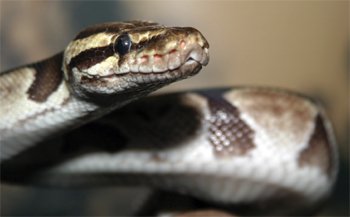Ball Python
Ball pythons get their name because they defend themselves by curling up into a tight ball and hiding their faces.
Design

While the python kind was vegetarian before the fall, ball pythons today are constrictors, which means they squeeze their prey until it dies. They flick their tongues to collect scents in the air. These are then pressed to the Jacobson’s organ on the roof of their mouths to be interpreted. Holes on their upper lips (heat pits) allow them to detect the body heat of small mammals and birds, their preferred prey. These heat pits can detect very slight temperature changes. All snakes are designed with the ability to open their jaws very wide, enabling them to swallow their prey whole. While feeding, ball pythons avoid choking because their windpipes are placed on the floor of their mouths so they aren't blocked by their prey.
Features
- While normally brown and black to camouflage with their habitat, ball pythons come in thousands of colors and patterns called morphs.
- This species is also known as the royal python because some African cultures consider them sacred and may wear them as living jewelry.
Fun Facts
- Female ball pythons wrap around their eggs to protect them and vibrate to warm them up.
- The teeth of the ball python face the back of the snake’s mouth, which helps the snake swallow its food.
Created Kind Members
Pigmy python, green tree python
CLASS: Reptilia (reptiles)
ORDER: Squamata (amphisbaenians, lizards, and snakes)
FAMILY: Pythonidae (pythons)
GENUS/SPECIES: Python regius
Size: 3–5 ft (0.9–1.5 m); females are larger than males
Weight: 3–5 lbs (1.3–2.3 kg)
Original Diet: Plants
Present Diet: Birds, Rodents
Habitat: Savannas and forests of western Africa, especially in the rainforests from Ghana to Cameroon
[Editor’s note: Some updates were needed for the Zoo Guide web series to reflect the latest behavioral, geographic distribution, and genetic studies of certain animals, as the original Zoo Guide was published in 2006.]
Zoo Guide
Make your next visit to the zoo more than just fun—make it factual and fascinating too! You could even start a personal “creation zoo tours” ministry. Featuring more than 100 animals, our long-awaited Zoo Guide includes beautiful pictures and explores the amazing facts and design features that point to our awesome Creator. Excellent gift for any one who loves animals!
Browse Kids Book- © 2025 Answers in Genesis
- Privacy Policy
- Contact
- About

